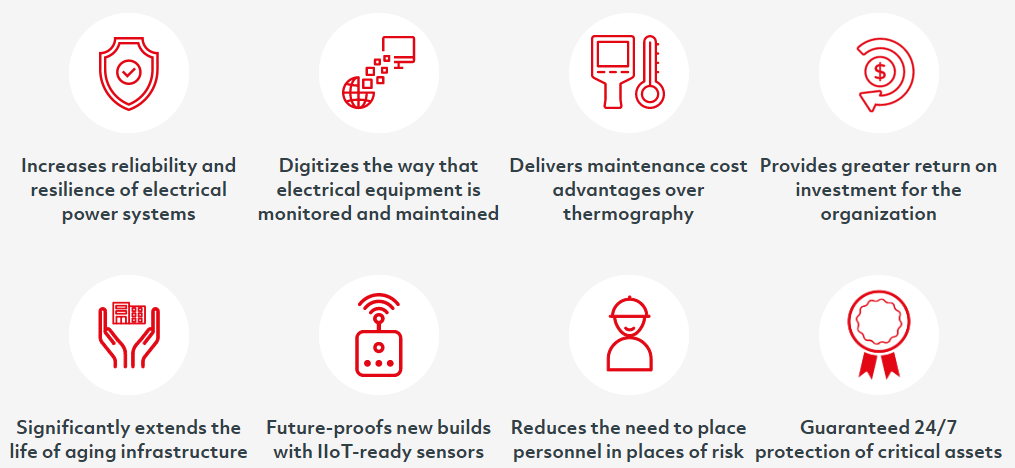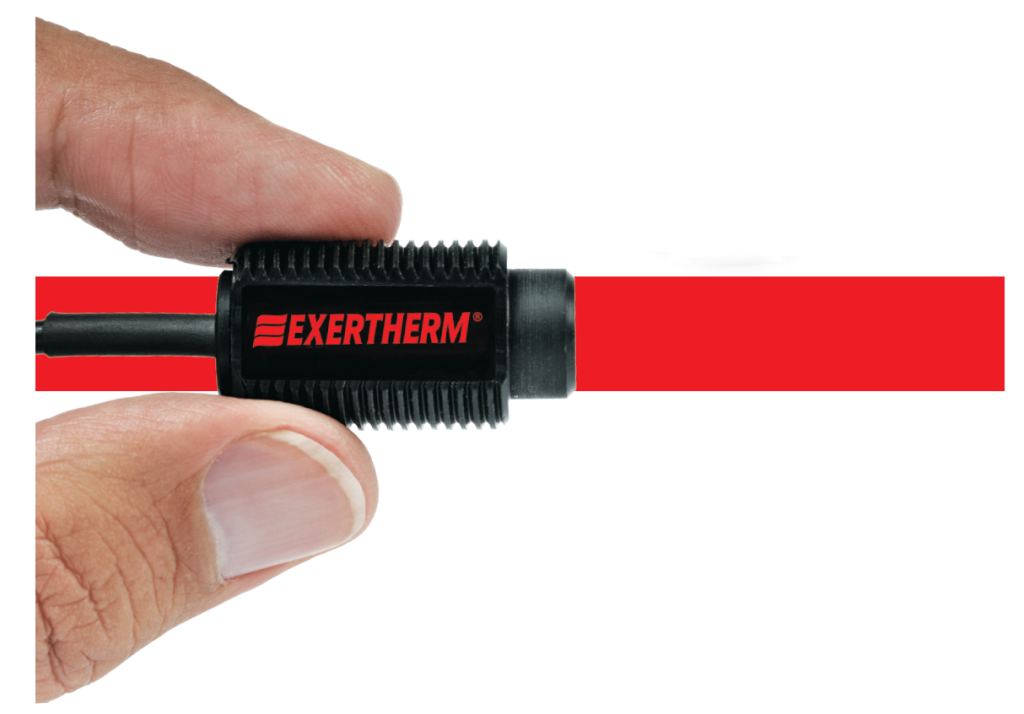
Thermal Monitoring for Electrical Equipment and Critical Infrastructure
Please allow us the opportunity to share with you information on Thermal Monitoring for Electrical Equipment and Critical Infrastructure to detect faults within your electrical infrastructure.
KVR Energy is the regional solutions partner for Exertherm® 24×7 Thermal Monitoring, which collects real-time temperature data for your critical assets, delivering enhanced safety, cost savings from increased efficiency, and countless other IIOT associated benefits.
What Is Thermal Monitoring?
One of the major causes of fire in electrical equipment is faulty joints or connections, where an increase in temperature is the primary symptom and an indicator that a potential problem could occur. Thermal monitoring enables organizations to detect the symptoms in those joints or connections that without intervention could otherwise lead to electrical outages, or worse, a fire.
Without early identification, the deterioration of faulty electrical joints or connections will lead to increased resistance and higher temperature, which will eventually result in thermal runaway and ultimately, a complete failure. Arc flash and fire, or even an explosion might occur, causing unexpected plant downtime, or potentially leading to catastrophic consequences such as total equipment destruction or even personnel injury.
Continuous thermal monitoring is the next technology step from periodic infrared inspection:
- Permanently installed sensors inside electrical equipment provide 24/7 protection
- Delivers real-time, integrated temperature data for critical electrical assets
This enables electrical maintenance teams to predict failures, safeguard electrical equipment, and optimize performance. With the disruption to power supply posing an increasingly critical threat to organizations, the requirement for innovative thermal monitoring solutions for industry to maximize uptime through the prediction of faults before they occur. Additional benefits delivered by this technology include increased personnel safety and extended asset lifespan.
Why Change From Inspection To Thermal Monitoring?
Thermal monitoring is an approach utilized by forward-thinking electrical engineering personnel to detect potentially costly and dangerous electrical faults in advance of failures. Sensors installed within important electrical assets will alert you to changes in status and detect potential faults that might have otherwise resulted in production downtime, asset damage, or injuries to personnel.
IIoT is irreversibly changing the way equipment is operated and maintained. It is therefore crucial that organizations are focusing their attention on the benefits of thermal condition monitoring as opposed to periodic inspection and accepting that this change to digitized maintenance is inevitable, bringing added value and extending the life of electrical infrastructure.
Benefits of thermal monitoring:

Most mission-critical facilities are already adopting a digitization strategy. As a result, there is a considerable risk for organizations that do not include the installation of condition monitoring sensors to automatically build in obsolescence to each piece of new equipment installed without thermal monitoring technology.
Thermal Monitoring Sensors
The use of condition monitoring sensor technology reduces the need for unnecessary periodic inspections to be carried out, instead allowing 24/7 remote observation of assets to provide continuous indicators around the condition status of electrical equipment.
Sensor technology helps electrical engineers, asset managers, and project teams build a more accurate picture of the condition of critical electrical infrastructure.
Specifically, thermal condition monitoring utilizes permanently installed sensors to identify hotspots on key connections (such as busbars and cables) within electrical infrastructure. This enables the detection of unexpected, expensive, and potentially damaging electrical faults before they develop into a major failure.
Thermal monitoring enables electrical engineering personnel to:
- Predict electrical faults and optimize maintenance
- Digitize and Integrate real-time data
- Increase asset resilience and maximize uptime
- Reduce OPEX costs and enhance operational efficiency
- Reduce risk and improve personnel safety

As awareness of the benefits of thermal condition monitoring technology grows, it is becoming more frequently used to monitor mission-critical electrical infrastructure. Thermal monitoring sensors can be installed in electrical assets such as LV/MV switchgear, Motor Control Centers (MCCs), Uninterruptable Power Supplies (UPS), Power Distribution Units (PDU’s), and dry transformers.
These essential electrical assets are used across a huge range of industries, including:

Surprisingly, a high-quality, permanently installed, and cost-effective thermal monitoring system for a facility’s electrical equipment is commonly overlooked. However, having increased thermal insight into key assets will enable the prevention of possible threats such as unplanned or unexpected facility downtime, expensive electrical asset repairs and replacements, and the risk of injury to personnel.
IIoT Sensors For Digitizing Electrical Maintenance
Thermal monitoring essentially resolves all the significant limitations associated with thermal camera inspections and closes the performance gap, thereby providing enhanced levels of protection, safety, operational uptime, and improved asset integrity.
Electrical maintenance teams will be able to check the condition of equipment from a remote location, 24/7. The move towards digitization and the Industrial Internet of Things (IIOT) signals the adoption of monitoring systems that allow for quicker diagnosis of potential problems, and enable end-users to take proactive action. This will help protect critical infrastructure and extend the lifespan of equipment by pre-empting potentially destructive events.
Permanently installed thermal monitoring solutions with integrated data are fully scalable, customizable, and configurable across any electrical infrastructure. IIOT recommendations require industrial equipment and machinery to have embedded monitoring sensors, which acquire condition data 24×7, with integration for subsequent analysis, and real-time identification of fault conditions.
This enables the most efficient maintenance practice to be adopted, enabling the considerable benefits over the life of the equipment which can be delivered as part of the IIOT and digitization of critical electrical infrastructure.
Summary
Thermal monitoring for electrical infrastructure is advantageous in a multitude of ways for any mission-critical organization looking to maintain uptime of critical electrical systems 24/7 x 365.
Thermal monitoring delivers the following benefits:
- IIOT-ready sensors provide integrated data – digitizing, and future-proofing equipment
- Optimizes maintenance by reducing the cost of repairs and replacement parts
- Alleviates downtime through advanced detection of failure symptoms
- Increases safety by removing people from places of risk
- Identifies best-performing equipment for future procurement decisions
- Provides OPEX savings from reduced ongoing periodic inspection and maintenance costs
The utilization of thermal monitoring sensors eliminates unnecessary periodic inspection and associated costs and reduces the intrusive maintenance to ‘as required’ by condition of equipment.
For organizations seeking a competitive edge over their rivals, it is important to future-proof critical electrical infrastructure and avoids building in obsolescence. Investment in thermal conditioning sensor technology creates an advantage not only by providing early warning of electrical faults that could ultimately halt production or services but through the protection of mission-critical assets, effectively prolonging lifespan and delivering greater return on investment (ROI) for the business.


